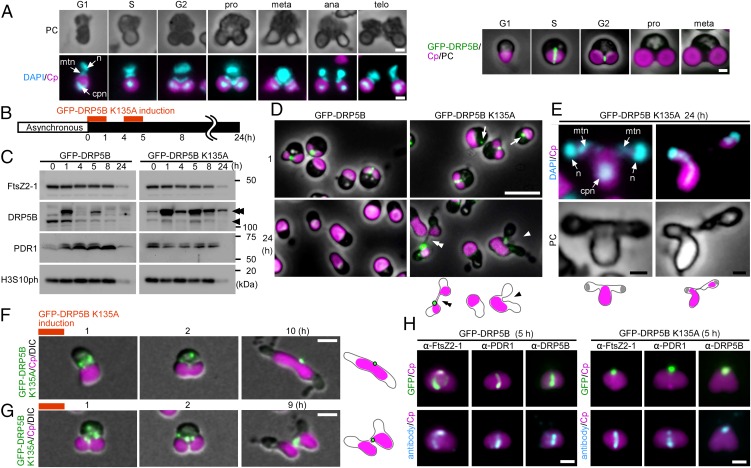Fig. 1.
Effect of the dominant-negative DRP5B K135A on chloroplast division and cell-cycle progression in C. merolae. (A) Representative DAPI-stained images of C. merolae cells and DRP5B localization during cell-cycle progression. Magenta, autofluorescence of the chloroplast; cyan, DAPI-stained DNA; green, GFP-DRP5B; cpn, chloroplast nucleoid; mtn, mitochondrial nucleoid; n, nucleus. For the DAPI-stained images, the corresponding phase-contrast (PC) images are also shown. (Scale bars: 1 µm.) (B) Schematic diagram of the culture conditions. GFP-DRP5B or GFP-DRP5B K135A cells cultured at 42 °C under light were transferred to dark to stop cell growth and entrance into the S phase. Then GFP-DRP5B or GFP-DRP5B K135A was expressed by two rounds of heat shock at 50 °C for 1 h. (C) Immunoblot analyses showing the change in the levels of the chloroplast-division proteins FtsZ2-1, DRP5B, and PDR1 and the M-phase marker H3S10ph in GFP-DRP5B and GFP-DRP5B K135A cells. The double arrowhead indicates GFP-DRP5B or GFP-DRP5B K135A, and the single arrowhead indicates endogenous DRP5B. GFP-DRP5B and GFP-DRP5B K135A samples were blotted on the same membrane. (D) Microscopic images of GFP-DRP5B or GFP-DRP5B K135A cells 1 and 24 h after the onset of the heat-shock treatment. The double arrowhead indicates the two cells connected by a GFP-positive tube-like structure. The arrowhead indicates the cell with one chloroplast and two nuclei. The arrows indicate aggregated GFP-DRP5B K135A. Green, GFP-DRP5B or GFP-DRP5B K135A; magenta, autofluorescence of the chloroplast. The images obtained by fluorescence and phase-contrast microscopy are overlaid. (Scale bars: 5 µm.) (E) DAPI-stained images of a cell with one chloroplast and two nuclei (Left) and a cell during cytokinesis in which chloroplasts are unequally inherited by daughter cells (Right). Magenta, autofluorescence of the chloroplast; cyan, DAPI-stained DNA. (Scale bar: 1 µm.) (F and G) Time-lapse observation of GFP-DRP5B K135A cells after the induction of expression. (F) GFP-DRP5B K135A was expressed before the onset of chloroplast division-site constriction. (G) GFP-DRP5B K135A was expressed during the course of chloroplast division-site constriction. Green, GFP-DRP5B K135A; magenta, autofluorescence of the chloroplast. The images obtained by fluorescence and differential interference contrast (DIC) microscopy are overlaid. (Scale bars: 1 µm.) The results are the same as shown in Fig. S2 in more detail. (H) Images obtained by immunofluorescence microscopy showing FtsZ2-1, PDR1, and DRP5B localization in the GFP-DRP5B– or GFP-DRP5B K135A–expressing cells. Cyan, FtsZ2-1, PDR1, or DRP5B (the anti-DRP5B antibody detects both GFP-tagged and endogenous DRP5B) detected by the respective antibodies (originally detected by orange fluorescence and converted to cyan); magenta, autofluorescence of the chloroplast; green, GFP fluorescence of GFP-DRP5B or GFP-DRP5B K135A. (Scale bars: 1 µm.) Two independent experiments produced similar results. The results from one experiment are shown.

